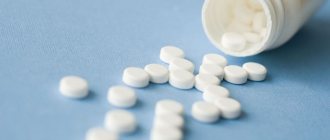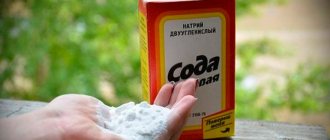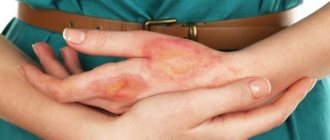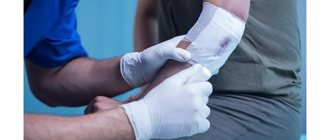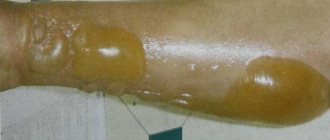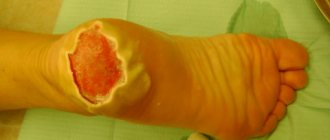Burns from boiling water, hot oil or any other hot liquids require an adequate and timely response, and if this happens, first aid should be provided immediately. Both the depth of tissue damage and the area of damage, as well as the healing period, will depend on this.
If this is a minor injury, you can provide first aid for a hand burn with boiling water yourself, but for serious injuries (3rd-4th degree burns), you should trust the doctors. Under no circumstances should the resulting blisters be opened, as this can lead to tissue infection. It is forbidden to sprinkle starch on burns, treat the wound with vegetable oil, iodine and other alcohol-containing liquids. All this can only increase pain and slow down healing. In case of particularly deep burns, when dirt and fragments of clothing have entered the wound, you should not try to clean the wound yourself, but rather wait for the doctors to arrive.
What are the dangers of deep skin burns?
Minor and superficial burns from heat exposure have little potential danger. Typically, the risks are associated not with the injury itself, but with improper care, during which the wound can become infected.
With a large area of damage, the danger is:
- shock – due to loss of plasma, the blood thickens, making it difficult for the kidneys, heart, lungs and other organs to function;
- toxemia – due to the destruction of cells, dangerous toxins enter the blood.
Toxemia does not occur immediately, but only a week after the injury, which causes problems with the timely access of the patient to a doctor.
Complications can be prevented by immediately contacting a surgeon or traumatologist.
Which doctor should I contact if I get a burn?
If you have a mild first-degree skin burn, you can contact a physician at the clinic. If the injuries are grade II, help can be provided by a surgeon or emergency room doctor.
Doctors who treat third- and fourth-degree burns are combustiologists. “Severe” victims, patients with burn disease and other complications are referred to them. It is extremely difficult to find a combustiologist in a district clinic; as a rule, doctors of this profile work in large or specialized medical institutions.
What to do if the skin peels off after a burn: first aid
Before starting treatment, you need to make sure that high temperatures or chemicals are no longer negatively affecting the skin. To do this, you need to remove clothing from the damaged part of the body and thoroughly rinse the wound with cold running water. If there is no water, then apply ice or snow.
If the area is very large or the degree of the burn is so severe that the victim cannot provide first aid to himself, you need to call an ambulance, wash the wound and wrap him in a clean cloth.
For minor wounds, you can give yourself first aid yourself.
- After washing the wound, you need to treat it with products that are designed to regenerate the skin. Olazol, Furaplast, and Panthenol, which is available in spray form, are well suited.
- With a severe burn, the skin peels off and a wound appears, which can become infected. Therefore, you need to apply a sterile bandage. Gel wipes should be placed under it to help restore the skin: GelePran, LitA-Tsvet-1. The dressing should be changed depending on the duration of action of the napkin: from 1 to 2.5 days.
- If there are no special preparations at hand, you need to treat the wound with any antiseptic that does not contain ethyl alcohol. Miramistin, a solution of furatsilin or potassium permanganate are suitable.
- In case of pain, you need to take a painkiller, for example, Analgin, Ketanov, Paracetamol.
After proper treatment of the wound, the affected skin begins to gradually recover. If your general health worsens, you should definitely consult a doctor.
Treatment of thermal burns
Of course, the main task and goal of treating a thermal burn is to restore the integrity of the skin. For superficial burns that do not involve the germ layer of the skin, regeneration occurs independently. If the burn damages the germ layer, healing is only possible through scarring, so with extensive deep burns there is a need for skin grafts.
In addition to measures aimed at restoring tissue integrity, treatment of burns has a number of other goals:
- pain relief;
- normalization of hemodynamics;
- restoration of water and electrolyte balance;
- normalization of blood pH;
- restoration of protein metabolism;
- prevention of liver, heart, lung, and kidney failure;
- detoxification of the body.
The first step in treating deep thermal burns is to thoroughly clean the burn wound. Foreign bodies, pieces of tissue, and exfoliated epidermis are removed from its surface under aseptic conditions and under local anesthesia. The wound is washed with hydrogen peroxide, after which the doctor decides on the method of further therapy. With the open method, a bandage is not applied to the area of burned skin. The closed method of therapy involves applying anti-burn ointment and subsequent dressing.
How to speed up further regeneration
There are 4 degrees of severity of burns depending on the area and depth of the affected skin. The first two stages can be treated at home independently, but the third and fourth stages can only be treated in a hospital setting.
A simplified way to determine the extent of the injury is to compare the size of the burn with a human palm. If the burned area is comparable to the size of your palm, you can restore your skin after a burn at home.
Pharmacy products
The purpose of drug treatment is to relieve inflammation and discomfort, speed up the healing of the wound where the skin has peeled off, and prevent complications.
- Most local medications already contain substances that relieve pain. But if their effect is not enough, you can take any analgesics (Analgin, Baralgin), non-steroidal anti-inflammatory drugs (Nimesulide, Nalgesin) in tablet form. Taking painkillers too often is dangerous: it can lead to an overdose and damage the stomach lining.
- Until a crust forms on the burn, a sterile bandage with ointments should be applied to the affected skin: Panthenol, Solcoseryl, Olazol. The drug applied to the burn promotes rapid healing of the tissue. It is more convenient to apply medications in aerosols, and they also reduce the risk of contracting an infection with your hands. When using ointments, sprays and gel wipes, you need to carefully study the instructions: some products need to be applied to the skin several times a day, others (LitA-Tsvet-1) once every 2-3 days.
- To regenerate the skin, the body must have resources that must be replenished through nutrition. The diet should be balanced, it should contain a sufficient amount of vitamins A, E, B. You need to drink as much as possible - up to 2 liters of water per day.
Until the burn heals completely, do not touch the skin with your hands, put pressure on the blisters, or tear off the crust.
Before treating a wound, you should thoroughly wash your hands and wipe them with an antiseptic.
It is important to monitor the dynamics of tissue healing and general well-being. If your body temperature rises, there is discharge from the burned tissues, or the pain intensifies, you should immediately consult a doctor. Such symptoms indicate that the injured skin has become infected or is not being treated correctly.
Physiotherapy
The process of skin regeneration after a burn occurs gradually. A favorable sign is the appearance of a crust on the wound. But if the wound gets wet, a crust will not form, and in this case the rehabilitation process can be accelerated with the help of physiotherapy.
A UV lamp, which is used in a hospital, helps dry the burn. If you have the necessary device at home, you can treat yourself. But first you need to visit a doctor who will tell you how often to use the physiotherapeutic device, what the frequency and duration of the procedures should be.
Other methods of physiotherapy also promote tissue healing:
- electrophoresis – accelerates regeneration and reduces the inflammatory process;
- ultrasound – reduces pain, prevents scar formation;
- laser – stimulates healing;
- darsonvalization – prevents the appearance of pus;
- photochromotherapy – soothes damaged skin;
- Magnetic therapy – improves blood circulation, due to which the skin heals faster;
- aeroionotherapy – reduces pain.
Each method has contraindications, so only the attending physician can prescribe them.
Traditional methods
For mild and shallow burns, damage to the skin can be treated at home using traditional therapy. It can be used only after consultation with a doctor.
- Place grated raw potatoes or potato starch on the wound under a bandage. Remove when the compress is warm.
- Apply a thoroughly washed cabbage leaf to the burn and secure with an elastic bandage. Remove after 1 hour.
- The aloe leaf is peeled or crushed, applied to the wound, and fixed with a bandage. The dressing is changed to a clean one after 2-3 hours.
- Mix the chopped onion with dandelion flowers and pour in unrefined oil. Boil the mixture, strain, and apply the resulting ointment to the burn 1-2 times a day. The product must be stored in the refrigerator. You should absolutely not use this ointment immediately after a burn - its components can worsen the damage. It is allowed to apply starting from 3-4 days.
The duration of traditional treatment is until a hard crust forms on the burn.
The disadvantage of folk remedies is their low effectiveness in comparison with pharmaceutical drugs. With a minor burn, they help speed up the recovery of peeling skin, but with severe injury they may be useless.
Why does skin peel off after sunbathing?
© jinjo0222988/Getty Images Pro
If the skin after tanning begins to peel and peel, it means that we did something wrong during the tanning process. In fact, the process of peeling the skin after sunbathing indicates only one thing - you got a sunburn
, accelerating several times the natural mechanism of aging and death of old skin cells.
The dead cells of the epidermis begin to intensively exfoliate, being rejected by the body; at the same time the skin is renewed
. Here are the most typical mistakes that can cause the skin to peel off intensively after tanning:
— exposure to the sun during the period of maximum solar activity;
- exposure to the sun regardless of skin type;
- prolonged exposure to the sun;
- exposure to the sun without using sunscreen and moisturizers;
— improper use of sunscreens and moisturizers.
Let's start with the fact that during the hours of maximum solar activity (usually from 11:00 to 15:00 - but this depends on the regions) it is better not to sunbathe at all
, and reduce your exposure to the sun during this period to a minimum. If you don’t like this approach, then you should be prepared to get burned and possibly start to peel.
If you belong to the group of people whose skin is most resistant to ultraviolet radiation (people with dark or very dark skin), then a short stay
exposure to the sun during peak solar activity may not cause your skin to peel.
What is prohibited to do
When providing first aid immediately after a burn has occurred, it is strictly forbidden to use fatty-based oils and ointments. They create a film on the skin that prevents heat from dissipating, causing thermal damage to worsen and the wound to become deeper.
When treating leather, do not use products containing alcohol. Once a scab appears on the burn, the risk of damage from alcohol is minimal. But given the choice and availability of safe antiseptics without alcohol, it is better to use them at all stages of treatment.
The main rule for treating a wound is not to injure it further. Therefore, patches or cotton wool should not be used. It will be difficult to tear them away from the wound, due to which the damaged tissues will be injured during each dressing.
Treatment of severe peeling hands
Common skin pathologies on the hands are treated with hormonal creams and ointments. The treatment regimen may include vitamins and antibiotics.
During the examination, the dermatologist will assess the condition of the skin, determine the cause and recommend additional measures that will alleviate the condition:
- take long, hot baths less often;
- moisturize the skin of your hands with oils;
- avoid soaps with an aggressive pH;
- use towels made of natural fabric.
General strengthening procedures promote rapid recovery.
It is important to normalize the diet and the diet itself, increase the body’s protective functions and improve metabolism. This is facilitated by physical exercise, acupuncture, massages, hirudotherapy, the effectiveness of which has been proven for skin diseases. August 16, 2021
Author of the article: dermatologist Mak Vladimir Fedorovich
Prevention
Burns can be avoided by carefully following safety precautions. It is possible to protect children from thermal and chemical damage if they are not allowed to be near sources of potential danger (household chemicals, stove, stove). Areas where hazardous substances are stored must be closed and chemicals must be placed on the highest shelf or in a locked cabinet.
You should always have medicines at home to provide first aid after a burn: special wipes, alcohol-free antiseptics, aerosols for skin regeneration.
What not to do
Burns from boiling water or chemical liquids are often accompanied by deep damage, and if the skin peels off and severe inflammation begins, then you should not delay treatment. Otherwise, all this can turn into a serious wound with purulent formations and abscesses.
During treatment, external agents with anti-burn and anti-inflammatory properties are used. But you still need to know what not to treat the injured area with:
- vegetable oil, ointments with a fatty base. After applying these products immediately after receiving a burn, complete heat exchange with the environment will be disrupted. As a result, the wound will not be able to cool down, it will only warm up more, and this will lead to a worsening of the condition and the development of severe inflammation;
- Do not use products containing alcohol. It dries out the tissue greatly, this will only worsen the condition and cause severe irritation;
- When the skin peels off after a burn, a weeping wound remains in its place. Its handling should be treated with the utmost care. It is not recommended to use many of the usual medications and ointments. If they are used on open wounds, this can lead to the development of serious complications;
- You can’t use brilliant green, iodine. Solutions will cause severe complications; after their application, chemical damage to injured tissues may occur;
- Do not apply tight bandages made of gauze or adhesive tape. It will be difficult to remove them from the burned area in the future.
Pharmacy products
If a child or adult is burned with boiling water and the skin peels off, it is important to treat the wound with special products that will relieve pain, have a cooling effect and speed up the regeneration process.
There are different medications available in pharmacies, but the most effective include the following medications with anti-burn, cooling, and anti-inflammatory properties:
- Levomekol . This is a combined external drug containing chloramphenicol and methyluracil. The indications indicate that the ointment helps in the treatment of boils, wounds with a purulent structure, trophic ulcers, and burn injuries. Excellent healing of wounds, has a bactericidal and analgesic effect. The ointment should be applied to a sterile napkin, which should be applied to the wound.
- Panthenol . If boiling water gets on the surface of the body, a burn occurs, and the skin peels off, then this remedy should be used as soon as possible. It is based on dexpanthenol, it accelerates the regeneration of the integument and reduces pain. For severe burn injuries, it is recommended to use the drug in the form of a spray; it is sprayed onto the surface of the injury, as a result it covers it with a thin film. When using ointment, it should be applied with light movements, do not rub.
- Olazol . The drug is available in the form of a spray. It contains several active components - chloramphenicol, anesthesin and sea buckthorn oil. It has an antibacterial, analgesic, anti-inflammatory effect. The product accelerates tissue regeneration. It is recommended to apply up to 4 times a day.
- Bepanten . The cream contains dexpanthenol. When used, it has anti-inflammatory, regenerating, analgesic, and antibacterial effects. Apply externally up to 2-3 times a day.
- Amprovisol . A combined drug that is available in the form of an aerosol. It contains anesthesin, propolis, vitamin D and menthol. When used, it has a cooling effect. The drug accelerates healing and prevents wound infection.
You definitely need to know how to treat a burn if the skin has peeled off. In this situation, you should exercise maximum caution. Do not rub or massage, this can lead to major injury, worsening of the condition, and infection. It is better to take off your clothes, wash the wound, treat it with an antiseptic and call a doctor, he will be able to carry out the necessary manipulations and prescribe the correct treatment, which will speed up the regeneration process.
Consequences of the procedure
Some consequences are not worth fearing. The procedure itself is a chemical burn, after which the cover begins to recover on its own. The level of collagen and the number of elastin fibers increase. New cells replace dead layers. This manifests itself in redness, peeling, burning and swelling.
Sometimes clients experience more serious reactions, which may require another visit to the dermatologist:
- Intense redness that becomes increasingly brighter and does not disappear within an acceptable recovery period.
- A watery rash indicates a violation of the procedure. Unpleasant consequences - spots, scars.
- Severe swelling, fever.
- Scars are a consequence of damage to drying crusts.
Such reactions occur if the remedy was chosen incorrectly, the specialist did not take into account contraindications or performed the session incorrectly. And also a negative reaction is sometimes provoked by the clients themselves if they do not follow the recommendations of their cosmetologist.
